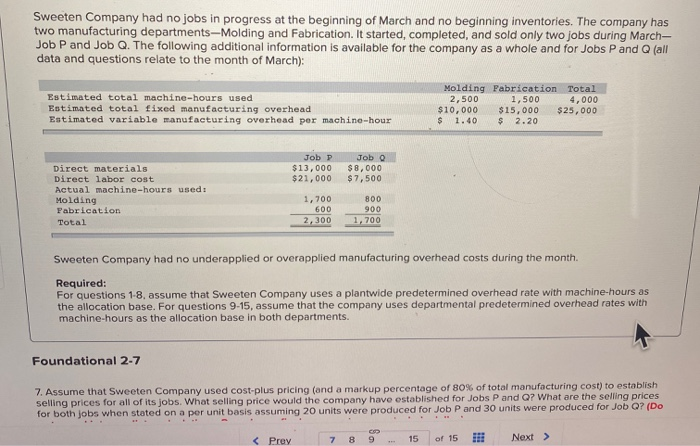Sweeten Company had no jobs in progress at the beginning of March and no beginning inventories. The company has two manufacturing departments---Molding and Fabrication. It started, completed, and sold only two jobs during March- Job P and Job Q. The following additional information is available for the company as a whole and for Jobs P and Q (all data and questions relate to the month of March): Estimated total machine-hours used Estimated total fixed manufacturing overhead Estimated variable manufacturing overhead per machine-hour Molding Fabrication Total 2,500 1,500 4,000 $10,000 $15,000 $ 25,000 $ 1.40 $ 2.20 Job P $13,000 $21,000 Jobo $8,000 $ 7,500 Direct materials Direct labor cost Actual machine-hours used. Molding Fabrication Total 1,700 600 2,300 800 900 1,700 Sweeten Company had no underapplied or overapplied manufacturing overhead costs during the month. Required: For questions 1-8, assume that Sweeten Company uses a plantwide predetermined overhead rate with machine-hours as the allocation base. For questions 9-15, assume that the company uses departmental predetermined overhead rates with machine-hours as the allocation base in both departments Foundational 2-7 7. Assume that Sweeten Company used cost-plus pricing (and a markup percentage of 80% of total manufacturing cost) to establish selling prices for all of its jobs. What selling price would the company have established for Jobs P and Q? What are the selling prices for both jobs when stated on a per unit basis assuming 20 units were produced for Job P and 30 units were produced for Job Q? (Do Job P $13,000 $21,000 Job o $8,000 $7,500 5 Direct materials Direct labor cost Actual machine-hours used: Molding Fabrication Total 800 1,700 600 2,300 900 1,700 Sweeten Company had no underapplied or overapplied manufacturing overhead costs during the month. Required: For questions 1-8, assume that Sweeten Company uses a plantwide predetermined overhead rate with machine-hours as the allocation base. For questions 9-15, assume that the company uses departmental predetermined overhead rates with machine-hours as the allocation base in both departments. ok int 0 Foundational 2-7 rences 7. Assume that Sweeten Company used cost-plus pricing (and a markup percentage of 80% of total manufacturing cost) to establish selling prices for all of its jobs. What selling price would the company have established for Jobs P and Q? What are the selling prices for both jobs when stated on a per unit basis assuming 20 units were produced for Job P and 30 units were produced for Job Q? (Do not round intermediate calculations. Round your final answers to nearest whole dollar) Job P Job a Total price for the job Selling price per unit ME 7 of 15








